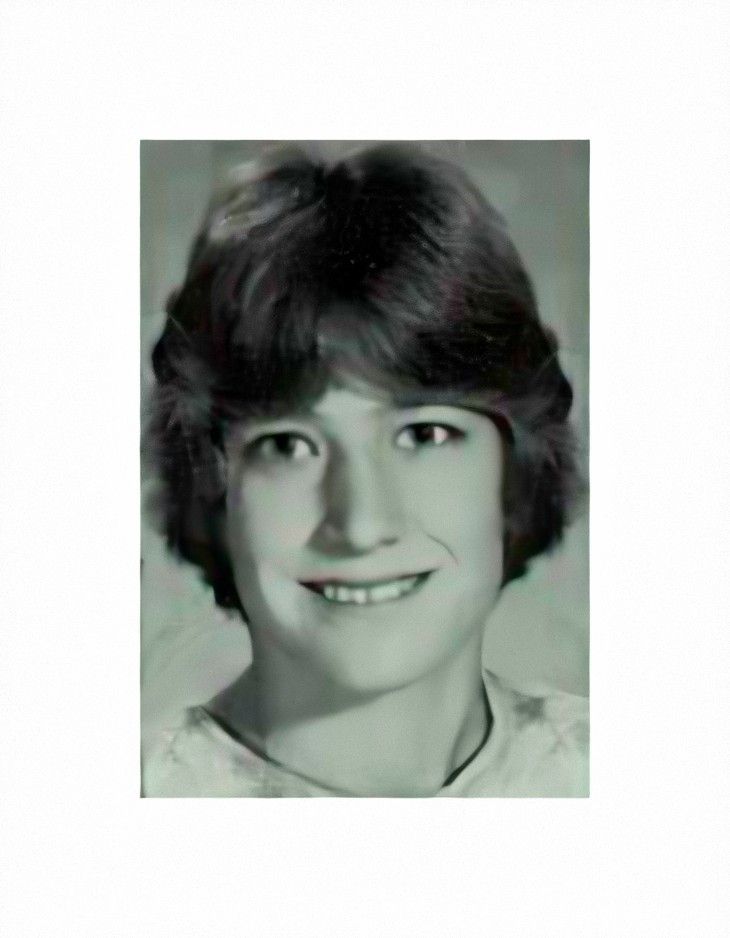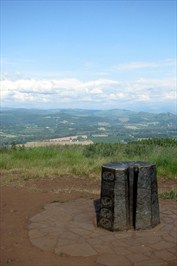The Oregon-based novelist Ken Kesey (author of 'One Flew Over the Cuckoo's Nest') wrote to his friends about the death:
'It was the toughest thing any of us has ever had to go through, yet is also had and always will have a decided glory. There was also the support we got from friends and family, from teachers and coaches and schoolmates. Without this support I don't think we would have attempted the kind of funeral we had. A homemade ceremony is legally possible. All you need is the land, the determination and the family.'
Jed Kesey's funeral
We built the box ourselves (George Walker, mainly) and Zane and Jed's friends and frat brothers dug the hole in a nice spot between the chicken house and the pond. Page found the stone and designed the etching. You would have been proud, Wendell, especially of the box - clear pine pegged together and trimmed with redwood. The handles of thick hemp rope. And you, Ed, would have appreciated the lining. It was a piece of Tibetan brocade given Mountain Girl by Owsley fifteen years ago, gilt and silver and russet phoenix bird patterns, unfurling in flames. And last month, Bob, Zane was goose hunting in the field across the road and killed a snow goose. I told him be sure to save the down. Susan Butkovitch covered this in white silk for the pillow while Faye and MG and Gretch and Candace stitched and stapled the brocade into the box.
It was a double-pretty day, like winter holding its breath, giving us a break. About 300 people stood around and sang from the little hymnbooks that Diane Kesey had Xeroxed - 'Everlasting Arms', 'Sweet Hour of Prayer', 'In the Garden', and so forth. With all my cousins leading the singing and Dale on his fiddle. While we were singing 'Blue Eyes Crying in the Rain', Zane and Kit and the neighbour boys that have grown up with all of us carried the box to the hole. The preacher is also the Pleasant Hill School superintendent and has known our kids since kindergarten. I learned a lot about Jed that I'd either forgotten or never known - like his being a member of the National Honour Society and finishing sixth in a class of more than a hundred.
We sang some more. People filed by and dropped stuff in on Jed. I put in that silver whistle I used to wear with the Hopi cross soldered on it. One of our frat brothers put in a quartz watch guaranteed to keep beeping every 15 minutes for five years. Faye put in a snapshot of her and I standing with a pitchfork all Grantwoodesque in front of the old bus. Paul Foster put in the little leatherbound New Testament given him by his father who had carried it during his 65 years as a minister. Paul Sawyer read from 'Leaves of Grass' while the boys each hammered in the one nail they had remembered to put in their pockets. The Betas formed a circle and passed the loving cup around (a ritual our fraternity generally uses when a member is leaving the circle to become engaged) (Jed and Zane and I are all members, y'unnerstand, not to mention Hagen) and the boys lowered the box with these ropes George had cut and braided. Zane and I tossed in the first shovelfuls. It sounded like the first thunderclaps of 'Revelations'.
The following is adapted from a postscript by George Walker about the making of Jed's coffin:
We selected some clear white boards for the sides and top. Nice looking and easy to work with, pine is also traditional.
It was a very good coffin, as coffins go, very beautiful everybody said, and certainly a labour of love. But I don't really believe that is the point. The real value of that coffin was in the doing, in the building of it ourselves. Not in the coffin, as a thing, but in the act of creating it, as an event. It made us all feel better to do this ourselves, to take charge of things as much as we could, not just the coffin but the burial as well. Perhaps it's because, when we lose someone close, particularly someone young and in the prime of life, we feel more than a little burned that things have been jerked so irrevocably beyond our control. Anything we can do to regain our handle on events is gratifying.
Whatever the reason, all who kept themselves actively involved in getting Jed buried agreed: we all gained something through our efforts. We felt better about it than if we had just turned it all over to the professionals, and gone about our business of feeling bad. So, I would say to anybody who feels that they might want to give it a try when someone close dies, absolutely yes; build it yourself. Even if you can't do basic carpentry, you can nail together a kit. If you do have skills, you can make something that will make you feel good long after it's buried out of sight. It doesn't have to be fancy; simple and neat is just fine, but do make it strong. You'll be surprised by the weight.
The Oregon-based novelist Ken Kesey (author of 'One Flew Over the Cuckoo's Nest') wrote to his friends about the death:
'It was the toughest thing any of us has ever had to go through, yet is also had and always will have a decided glory. There was also the support we got from friends and family, from teachers and coaches and schoolmates. Without this support I don't think we would have attempted the kind of funeral we had. A homemade ceremony is legally possible. All you need is the land, the determination and the family.'
Jed Kesey's funeral
We built the box ourselves (George Walker, mainly) and Zane and Jed's friends and frat brothers dug the hole in a nice spot between the chicken house and the pond. Page found the stone and designed the etching. You would have been proud, Wendell, especially of the box - clear pine pegged together and trimmed with redwood. The handles of thick hemp rope. And you, Ed, would have appreciated the lining. It was a piece of Tibetan brocade given Mountain Girl by Owsley fifteen years ago, gilt and silver and russet phoenix bird patterns, unfurling in flames. And last month, Bob, Zane was goose hunting in the field across the road and killed a snow goose. I told him be sure to save the down. Susan Butkovitch covered this in white silk for the pillow while Faye and MG and Gretch and Candace stitched and stapled the brocade into the box.
It was a double-pretty day, like winter holding its breath, giving us a break. About 300 people stood around and sang from the little hymnbooks that Diane Kesey had Xeroxed - 'Everlasting Arms', 'Sweet Hour of Prayer', 'In the Garden', and so forth. With all my cousins leading the singing and Dale on his fiddle. While we were singing 'Blue Eyes Crying in the Rain', Zane and Kit and the neighbour boys that have grown up with all of us carried the box to the hole. The preacher is also the Pleasant Hill School superintendent and has known our kids since kindergarten. I learned a lot about Jed that I'd either forgotten or never known - like his being a member of the National Honour Society and finishing sixth in a class of more than a hundred.
We sang some more. People filed by and dropped stuff in on Jed. I put in that silver whistle I used to wear with the Hopi cross soldered on it. One of our frat brothers put in a quartz watch guaranteed to keep beeping every 15 minutes for five years. Faye put in a snapshot of her and I standing with a pitchfork all Grantwoodesque in front of the old bus. Paul Foster put in the little leatherbound New Testament given him by his father who had carried it during his 65 years as a minister. Paul Sawyer read from 'Leaves of Grass' while the boys each hammered in the one nail they had remembered to put in their pockets. The Betas formed a circle and passed the loving cup around (a ritual our fraternity generally uses when a member is leaving the circle to become engaged) (Jed and Zane and I are all members, y'unnerstand, not to mention Hagen) and the boys lowered the box with these ropes George had cut and braided. Zane and I tossed in the first shovelfuls. It sounded like the first thunderclaps of 'Revelations'.
The following is adapted from a postscript by George Walker about the making of Jed's coffin:
We selected some clear white boards for the sides and top. Nice looking and easy to work with, pine is also traditional.
It was a very good coffin, as coffins go, very beautiful everybody said, and certainly a labour of love. But I don't really believe that is the point. The real value of that coffin was in the doing, in the building of it ourselves. Not in the coffin, as a thing, but in the act of creating it, as an event. It made us all feel better to do this ourselves, to take charge of things as much as we could, not just the coffin but the burial as well. Perhaps it's because, when we lose someone close, particularly someone young and in the prime of life, we feel more than a little burned that things have been jerked so irrevocably beyond our control. Anything we can do to regain our handle on events is gratifying.
Whatever the reason, all who kept themselves actively involved in getting Jed buried agreed: we all gained something through our efforts. We felt better about it than if we had just turned it all over to the professionals, and gone about our business of feeling bad. So, I would say to anybody who feels that they might want to give it a try when someone close dies, absolutely yes; build it yourself. Even if you can't do basic carpentry, you can nail together a kit. If you do have skills, you can make something that will make you feel good long after it's buried out of sight. It doesn't have to be fancy; simple and neat is just fine, but do make it strong. You'll be surprised by the weight.
Family Members
Sponsored by Ancestry
Advertisement
Records on Ancestry
Advertisement





